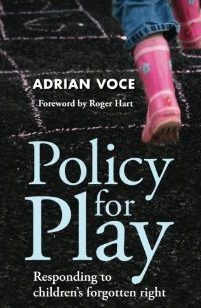
10 features of the playful city
In this final part of his article on the importance of government policy for children’s play, Adrian Voce sets out ten changes that could be achieved by the cross-departmental, multi-level approach, embodied by the short-lived English Play Strategy, and which is now advocated by the UN.
The reason to explore the Play Strategy for England as a case study in national government policy for this neglected children’s right, is that it took the kind of long-term, cross-cutting, multi-faceted approach now advocated by the UNCRC and suggested by any serious analysis of children’s play and the space they need for it.
Furthermore, although abandoned as part of the coalition government’s austerity measures in 2010-11, the Play Strategy only included substantial funding (in national government terms) for the first phase of its planned ten years. The remaining phases were to cultivate the cross-departmental collaboration, nationally and locally, to create the genuinely child-friendly, playable neighbourhoods wherever children lived that was the policy’s ultimate aim. This activity would not have cost the 100s of millions invested in the new playgrounds of the first three years. Its impact was rather dependent upon a strategic commitment from different branches of government to adopt crosscutting policies, utilise existing resources and make future investment decisions differently – taking much greater account of the child’s perspective, and children’s stake in a shared public realm.
Unavoidable
Leaving aside the unavoidable conclusion that axing the Play Strategy was therefore more about reining in the role of the state than it was about saving money, it follows that austerity per se, should be no real obstacle to the kind of concerted, joined-up thinking about children and their environment that the UNCRC and the whole child-friendly city movement is calling for.
if there is once again genuine political interest in revisiting a national government play policy for England, what might it achieve? And, regardless of national government, what might local authorities do now to make their towns and cities more playable?
Each individual city will have its own unique circumstances, culture and demographics to consider. Nevertheless, there are some common themes and principles. Here, not as an exhaustive list, are ten suggestions for creating the truly playful city.
- End the domination of traffic over the streets (i.e. roads) where most children live. Pedestrianised areas, home zones and play streets should be the norm for urban communities.
- Prioritise the design element of public space and housing in new developments, to embed playful affordances within the built environment.
- Break the mould of the public playground: children’s space to play should not be defined by fences, safety surfaces and equipment but integrated throughout a liveable, intergenerational landscape.
- Allow unplanned space to evolve according to communities’ use of it. This will tend to give rise to the spatial ‘fields of free action’ (Kytta, 2004) that children will populate and animate with their play.
- Build and staff more traditional adventure playgrounds, especially in the most deprived areas, where safe public space is rare.
- Make parks work for everyone, including teenagers. Too many public parks are effectively no-go areas for a city’s youth, who are designed out as a perceived threat to genteel society and manicured floral displays.
- Make childcare services truly child- (as distinct from parent-) friendly, by staffing them with qualified playworkers. Teaching assistants, however dedicated, naturally tend to apply the same behavioural regime that operates in the classroom – effectively consigning some children to 8 hours or more of school per day.
- Welcome children into public space by banning ‘mosquito devices’, encouraging and supporting ‘playing out sessions’, and reviewing how anti-social behaviour is defined.
- Open up school grounds for neighbourhood play. Schools are by far the greatest recipient of public funding for children and yet – even leaving aside questions about education and curriculum – are massively under-utilised as community assets, being gated and out-of-bounds for all who do not attend, even when school is out.
- Develop safe routes to schools, parks and play areas. Mobility is a key: the child friendly, playful city will have a web of safe, accessible and familiar routes to give children the connectivity that adults take for granted.
Concerted action
Many of these measures are within the gift of municipalities but others are, to a greater or lesser extent, dependent on national commitments too. High-level policies on education, planning, public health, law and order and transport each have a bearing on local decisions that either constrain or enable children’s play opportunities. This is why the All Party Parliamentary Group, the leader of the Labour Party, and the UN Committee on the Rights of the Child each say it is unacceptable that not a single minister in the current UK government has children’s play within his or her policy portfolio; and why they are each calling for concerted national action on children’s right to play.
For advocates, the argument about whether such policy is a response to the children’s rights agenda, or a means to address ‘more immediate’ problems is a false dichotomy. What matters is that governments – national and local – take children’s play seriously. That they accept their responsibility to plan and provide space for it. That they address the barriers to it. That they promote awareness and understanding about children’s need for it. And that they ensure that all such measures are informed by the best and most up-to-date knowledge about it.
Adrian Voce
Photo: Garett Gabriel
The first four parts of this article can be read here: Part 1, part 2, part 3, part 4.
Policy for Play by Adrian Voce is published by Policy Press.





